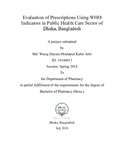| dc.contributor.advisor | Chowdhury, Fabliha Ahmed | |
| dc.contributor.author | Abir, Md. Wasiq Dayem Minhazul Kabir | |
| dc.date.accessioned | 2019-01-06T05:27:17Z | |
| dc.date.available | 2019-01-06T05:27:17Z | |
| dc.date.copyright | 2018 | |
| dc.date.issued | 2018-07 | |
| dc.identifier.other | ID 14146013 | |
| dc.identifier.uri | http://hdl.handle.net/10361/11076 | |
| dc.description | This project report is submitted in partial fulfilment of the requirements for the degree of Bachelor of Pharmacy, 2018. | en_US |
| dc.description | Catalogued from PDF version of project report. | |
| dc.description | Includes bibliographical references (page 44-46). | |
| dc.description.abstract | Standardization of medical treatment is actually a broad aspect, however in spite of that; World Health Organization (WHO) has developed a number of indicators to assess the quality of health care. The indicators are categorized in three different groups: prescribing indicators, patient care indicators and facility indicators. In this study, we aimed on the evaluation of prescribing indicators in four different public hospitals in Dhaka, Bangladesh. The hospitals are: Dhaka Medical College, Shaheed Suhrawardy Medical College, National Institute of Cancer Research & Hospital and National Institute of Diseases of the Chest and Hospital. We collected 50 prescriptions from each hospital and in total of 200 prescriptions were collected and assessed. After analysis we found that on average of 6.16 drugs are prescribed per encounter where the standard value is 1.6-1.8; about 51% prescription contained one or more antibiotic where the standard value is 20.0%-26.8%; about 46% encounters were with one or more injections even though the standard value is just 13.4%-24.1%; only 14.7% drugs were prescribed using generic names whereas the value should be 100% and lastly 41.3% drugs were prescribed from Essential Drug List but the standard is 100%. This study contains lists of different type of injections and antibiotic drugs prescribed to the individuals. From this study we can conclude that we are in need of strict scrutiny on the prescribing methods of our country, so that we can help in achieving the ideal environment for medical treatment. | en_US |
| dc.description.statementofresponsibility | Md. Wasiq Dayem Minhazul Kabir Abir | |
| dc.format.extent | 46 pages | |
| dc.language.iso | en | en_US |
| dc.publisher | BRAC University | en_US |
| dc.rights | BRAC University project reports are protected by copyright. They may be viewed from this source for any purpose, but reproduction or distribution in any format is prohibited without written permission. | |
| dc.subject | WHO | en_US |
| dc.subject | Public health care | en_US |
| dc.subject.lcsh | Medical care--Bangladesh. | |
| dc.subject.lcsh | Public health. | |
| dc.subject.lcsh | World Health Organization. | |
| dc.title | Evaluation of prescriptions using WHO indicators in public health care sector of Dhaka, Bangladesh | en_US |
| dc.type | Project report | en_US |
| dc.contributor.department | Department of Pharmacy, BRAC University | |
| dc.description.degree | B. Pharmacy | |

